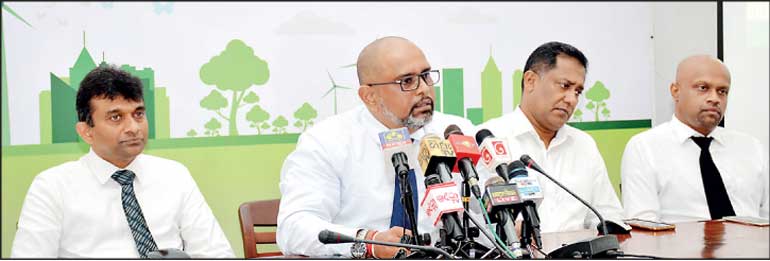Monday Apr 07, 2025
Monday Apr 07, 2025
Friday, 30 September 2022 00:28 - - {{hitsCtrl.values.hits}}

Small Hydro Power Developers Association (SHPDA) President Thusitha Peiris (2nd from left) addressing the media yesterday. Others from left: Grid Connected Solar Association President Lasith Wimalasena, SHPDA former President Prabath Wickramasinghe and Secretary and legal advisor Warna Dahanayake – Pic by Upul Abayasekara
By Darshana Abayasingha
The Federation of Renewable Energy yesterday raised concerns of a concerted effort to scuttle the progress of the sector to boost profitability of the CEB.
Addressing a media briefing in Colombo, Federation representatives remarked that on the back of an unfavourable tariff structure its membership has not received payments for 10 months and warned of a prolonged more intense power crisis should the Government and authorities continue to ignore the prospects of renewable energy.
Had Sri Lanka’s energy authorities not suspended connecting new mini hydro projects to the grid in 2015, and expanded solar and other renewable energy sources to 25% of grid capacity, the country would not face a massive power crisis as it does today, the Federation states.
But no Government paid attention to this matter, whilst certain officials have provided wrong advice for vested reasons, they said.
The renewable energy sector provides over 1,300 MW in energy to the national grid through mini hydro, wind, solar and bio mass projects. This constitutes 14% of the current national energy mix that consumes over 17,000 GWh annually.
Small hydro plants provide 426 MW of power, whilst roof-mounted solar contributes 627 MW and another 121 MW from ground solar systems.
“We continue to engage all segments of Government to encourage them to expand interest and investment in the renewable energy sector, and to recover our payments. We have connected 1,300 MW. Despite non-payment by the CEB, we are not disconnecting our supply.
“This has been taken for granted. If we discontinue our supply, all segments of Sri Lankans and industry will suffer and power cuts will become longer, but we won’t do that. We don’t want to make things worse. But they are not paying us in a timely fashion because we are keeping it connected,” said Lakmal Fernando.
The Federation says renewable energy offers the best and speediest solution to the country’s burgeoning energy crisis, and the decision by the CEB to halt the expansion of mini hydro and other renewable sources is costing the country over $ 800 million annually due to dependency on fuel and coal powered plants.
It costs Rs. 17 per unit to generate a unit of electricity via renewable sources, whilst the costs spikes to Rs. 37.50 and Rs. 106 for coal and fuel respectively. The renewable energy bill is currently only 5% of the CEB’s total expenditure for generation, but they still continue to hold payments lamented the Federation.
“This is the only industry that can provide a solution and provide it soon. Why are they not coming forth with the solution? Over 4,500 MW of renewable energy needs to be added to the grid to realise the Government’s ambition of 70% renewable by 2030, but there is no interest in this matter and only 225 MW would have been added by next year, if the economy recovers.
“Policymakers are to blame in the CEB and the Ministry, and then politicians. For instance does it take a politician to say pay the renewable energy sector? Why are the officials not doing it, when they know herein lies the solution,” stated the Federation’s Prabath Wickremasinghe.
The industry body also pointed out that due to non-payment by the CEB some service providers have been forced to borrow at exorbitant rates to maintain operations.
It added that banks have begun to list the renewable energy sector as a high-risk segment, and this would augur badly to attracting new investments in the area. They said over 150 MW of small hydro projects are awaiting clearance, whilst there lies potential for 700 MW of rooftop solar systems. Despite the Ministry of Power calling for Expressions of Interest for projects above 50 MW and receiving 6,000 MW worth of applications, very little progress has been made in the matter.
Discover Kapruka, the leading online shopping platform in Sri Lanka, where you can conveniently send Gifts and Flowers to your loved ones for any event including Valentine ’s Day. Explore a wide range of popular Shopping Categories on Kapruka, including Toys, Groceries, Electronics, Birthday Cakes, Fruits, Chocolates, Flower Bouquets, Clothing, Watches, Lingerie, Gift Sets and Jewellery. Also if you’re interested in selling with Kapruka, Partner Central by Kapruka is the best solution to start with. Moreover, through Kapruka Global Shop, you can also enjoy the convenience of purchasing products from renowned platforms like Amazon and eBay and have them delivered to Sri Lanka.
Discover Kapruka, the leading online shopping platform in Sri Lanka, where you can conveniently send Gifts and Flowers to your loved ones for any event including Valentine ’s Day. Explore a wide range of popular Shopping Categories on Kapruka, including Toys, Groceries, Electronics, Birthday Cakes, Fruits, Chocolates, Flower Bouquets, Clothing, Watches, Lingerie, Gift Sets and Jewellery. Also if you’re interested in selling with Kapruka, Partner Central by Kapruka is the best solution to start with. Moreover, through Kapruka Global Shop, you can also enjoy the convenience of purchasing products from renowned platforms like Amazon and eBay and have them delivered to Sri Lanka.